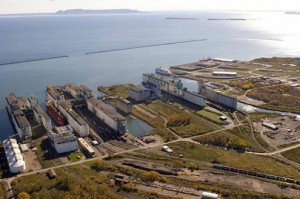 THUNDER BAY – The Joint Task Force (JTF) is proposing that the boundaries of the Northwestern Ontario Regional Economic Development Planning Zone will be broad, encompassing the entire region, with the option of including Nishnawbe Aski and Métis Nation territories. “Northwestern Ontario is a distinct geographic, economic and social region within Canada. The challenges it faces are different and the contributions it makes to the province and country are unique.
THUNDER BAY – The Joint Task Force (JTF) is proposing that the boundaries of the Northwestern Ontario Regional Economic Development Planning Zone will be broad, encompassing the entire region, with the option of including Nishnawbe Aski and Métis Nation territories. “Northwestern Ontario is a distinct geographic, economic and social region within Canada. The challenges it faces are different and the contributions it makes to the province and country are unique.
The complex decisions affecting the Northwest are best understood and made by those who live here. To be heard clearly by the other regions of the Province and country, Northwestern Ontario must operate as consensual union that speaks clearly on common areas of interest”. JTF chair Iain Angus said that the boundaries and makeup of a regional economic development zone are vital considerations in the creation of the zone, with a variety of factors to be considered.
“In developing our position on this matter, we recognized the requirement to acknowledge the diverse needs of different sectors and different types of communities and
to be in a position to give an accurate representation of each group towards common goals”, he said.
Angus said that additional factors taken into account in defining the zone included the region’s history of collaboration, the need for efficiencies, the importance of region-wide communication, the region’s infrastructure, the importance of involving Métis and First Nations communities and subregional differences.
“A key consideration when defining the zone was the long history of Northwestern Ontario collaboration that exists, through organizations like the Northwestern
Ontario Municipal Association, the Northwestern Ontario Associated Chambers of Commerce, Common Voice Northwest, the Northwestern Ontario Development Network and others”, he said. “Common Voice Northwest, for example, through its Energy Task Force, which originated with NOMA, has led the campaign to ensure
that the needs of the Northwest for electrical distribution and transmission are recognized by the government in its long term plans for the region”, he added.
Angus pointed out that another example of a successful Northwestern Ontario-wide initiative was the drive to attract the Northern Ontario School of Medicine to Thunder Bay, with many Northwestern Ontario communities and Treaty organizations successfully working to support this initiative.
Yet another practical example of regional cooperation, he said, is the work of the North Superior Workforce Planning Board in its push to formulate the concept of a Public Policy Research Institute and successfully lobby for it and see it emerge as one of the key pillars of the Northern Growth Plan. Support for the concept was
garnered across the region through Common Voice Northwest.
A major issue identified in the JTF’s regional consultations is that smaller communities often do not have discretionary resources for matching funds for infrastructure
or other projects due to the fact that their industrial tax base is almost gone and their residential tax base is struggling to maintain the status quo. Other communities, who rely solely on a residential tax base, find their aging population unable to fund inflation increases let alone any expansion or capital replacement.
Adopting a region-wide approach to economic development will serve to level the playing field for disadvantaged communities and utilize all of the assets that our region has to offer.
The objective of this research study was to identify shared economic development priorities, issues, barriers, successes and opportunities in all sectors across the
Northwestern Ontario region. Such information would serve as the basis for the development of a regional approach to economic development and a planning model.
So far, the study incorporates interviews with about 20 key Thunder Bay-based regional leaders and economic development practitioners as well as extensive regional consultation with over 40 individuals and organizations. The views expressed were from the perspective of the organizations that they represented and therefore
provide an opportunity to view issues from different angles. This approach tends to strengthen the findings which will require further study and analysis to substantiate.
Key Findings:
Key findings show a common view that there are systemic barriers (silos and bureaucracy) within the provincial ministries that mostly affect development at the regional
and local levels. Specifically, inquiries to Ministry of Innovation and Research, Investment and Trade, Agriculture and Aboriginal Affairs are usually delegated to the local MNDMF office which does not have the resources or capability to deal with them effectively.
The other Ministries that are viewed as barriers to development are the MTO, MNR and MOE. The consistent theme in their case is that they view their function as one of regulators where the need is for being facilitators. The consensus seems to be that unless some changes are made, this will continue to be a major drag on regional economic expansion. The other major finding is that, while sharing similar issues of high transportation costs, energy costs (hydro rates), more clarity on Aboriginal consultation protocol, the need for a stronger FedNor presence at the table, land use planning, etc., there are substantial differences between the sub-regions of Northwestern Ontario. A section of the upcoming report will be dedicated to highlight the need for a regionwide economic development zone and this will be expanded to include the specific areas of need for a multi-layered approach in phase II of the study once additional research is conducted.
Given all of the issues and barriers to development that have been identified, this initial research has also found evidence of many successes and areas of future opportunities. These have been broken down by sectors to facilitate the analysis and follow-up.
Conclusion
The initial evidence shows a region that is blessed with vast natural resources and human capital, but is still struggling to come out of a long-term recession. There is evidence of many successes and great opportunities but also a view that the government needs to take a much closer look at the systemic barriers that are limiting economic development and expansion.

As well, the sub-regions of the Northwestern Ontario region are unique in their needs, opportunities, and approaches to economic development and, for any model to be successful, it will also require a tailored approach. The case is becoming apparent for a multi-layered approach where certain policies and programs would benefit from a region-wide application, while others would require a more focused sub-regional implementation. Consistent to the variable approach is the fundamental question for a more localized decision-making process.
The Summit on June 13 and 14 will aid in refining our preliminary results and assist us in focusing on what we want in the pilot project.
Frank Pullia
Frank Pullia is the chief researcher for the Regional Economic Development Planning Zone. He can be reached at (807) 767-6579 or via e-mail at frank@frankpullia.com

